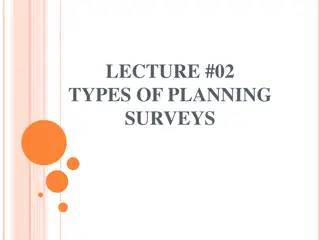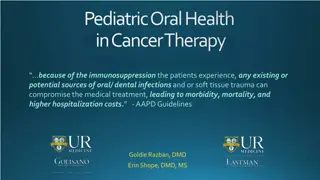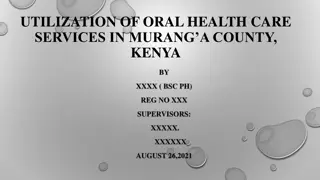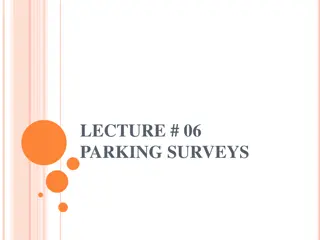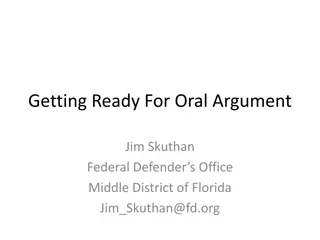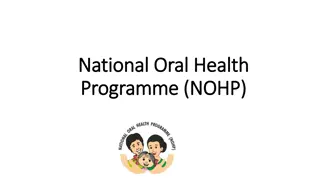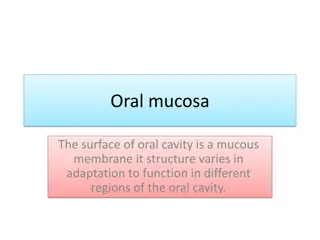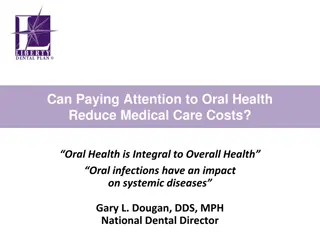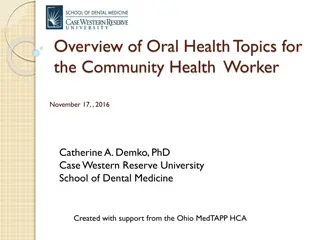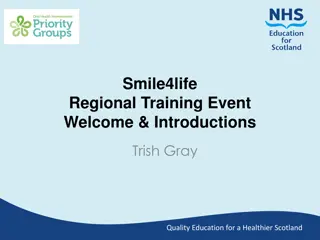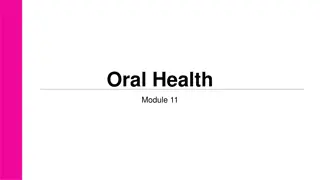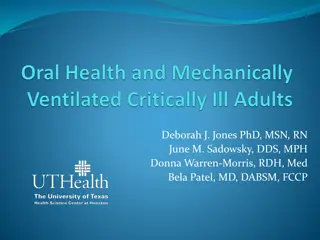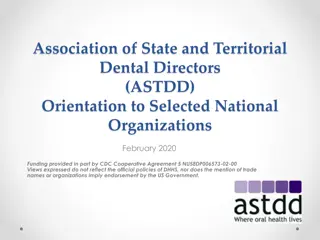Essential Guide: Surveys in Oral Health Research
Explore surveying techniques, types, data collection methods, and steps in oral health research. Understand survey objectives, designing investigations, sampling techniques, data analysis, and result publication. Utilize surveys for monitoring, assessment, and policy development in oral health.
Download Presentation

Please find below an Image/Link to download the presentation.
The content on the website is provided AS IS for your information and personal use only. It may not be sold, licensed, or shared on other websites without obtaining consent from the author. Download presentation by click this link. If you encounter any issues during the download, it is possible that the publisher has removed the file from their server.
E N D
Presentation Transcript
CONTENTS Survey (Surveying) Types of surveys Uses of surveys Methods of data collection Steps in surveying BASIC ORAL HEALTH SURVEYS
Surveying It is a non-experimental type of research that attempts to gather information about the status quo for a large number of people by describing present conditions without directly analyzing their causes.
Types of surveys Descriptive studies-describe Analytical studies-analyse or explanatory Cross-sectional studies- prevalence Longitudinal studies-incidence
USES OF SURVEYS Monitoring trends in oral health and disease Assessment of dental needs Insight into health related issues Policy development Program evaluation
METHODS OF DATA COLLECTION Health records Health interview survey Health examination survey Questionnaire Telephones Mailed questionnaires
STEPS IN SURVEY PROCEDURES 1. Establishing the objectives. 2. Designing the investigation. 3. Selecting sample. 4. Conducting (organizing) examination. 5. Analyzing the data. 6. Drawing the conclusions. 7. Publishing the results.
1. Establishing the objectives Objective should be clear,precise,relevant The objectives of oral health survey usually are: i. Initially to provide a full picture of oral health status and needs of population. ii. Subsequently to monitor changes in disease levels or pattern.
2. Designing the investigation Survey protocol- written form and should contain-objective, type of information, approval, needful resources in terms of money, manpower, time Sampling methods Statistical methods Approval from authorities
3. Selecting the sample Not all individuals are included in the survey Sample is the subset of the population under investigation. Select the sample which is Representative of the population using one of the methods of sampling technique. Obtain consent from study group
4. Conducting (organizing) examination Scheduling - to prevent wastage of resources Instruments and supplies - mouth mirrors, probes, tweezers, sterilizing solutions, gloves, masks, towels etc Infection control measures Examination area & type of examination Training and Calibrating examiners
The objectives of standardization and calibration are To ensure uniform interpretation, understanding and application of the criteria for the various diseases and conditions to be observed and recorded. To ensure that the each examiner can examine to a uniform standard and to minimize variation between different examiners.
5. Analyzing the data Statistical analysis using appropriate tests Interpretation of the results 6. Drawing the conclusions After the results are obtained, conclude the survey
7. Publishing the results Introduction Purpose of the study Material and methods Results Discussion Conclusions
Oral health survey Oral health survey is the process of collecting information about oral health status and treatment needs that is needed for planning or monitoring on a group of people. Basic Oral health survey Used to collect information about oral health status and treatment needs of population BASIC ORAL HEALTH SURVEYS
PATHFINDER SURVEYS Practical, economic survey sampling method It is a stratified cluster sampling method that aims to include most important population subgroups It proposes appropriate numbers of subjects in specific index age groups CLASSIFICATION: PILOT SURVEY NATIONAL PATHFINDER SURVEY
PILOT SURVEYS Only the most important sub groups in population & 1 or 2 index ages(usually 12 years & another age group) Minimum data is required NATIONAL PATHFINDER SURVEYS All important subgroups & atleast 3 of index age groups National wide surveys-for planning and monitoring services Random sampling is employed-many sample sites
INDEX AGE GROUPS 5 years- between 5th & 6th birthday,caries in primary teeth,age at which children begin primary school 12 years- leave primary school,all permanent teeth are erupted(except 3rd molars)-Global monitoring age 15 years- permanent teeth exposed to oral environment for 3-9 years, assesssment of periodontal disease indicators 35-44 years(mean 40 years)- adults, standard monitoring group-caries,periodontal status 65-74 years(mean 70 years)- represents geriatric group
WHO ORAL HEALTH ASSESSMENT FORM (1997) Universally accepted and used recording methodology for oral health surveys. Standard codes are used So designed that they facilitate computer processing Uses FDI system of notation
WHO ORAL HEALTH ASSESSMENT FORM (1997) Survey identification & general information Extra oral examination TMJ assessment Oral mucosa Enamel opacities /hypoplasia Dental fluorosis Periodontal status(CPI) Loss of attachment Dentition status and treatment needs Prosthetic status Prosthetic need Dentofacial anomalies Need for immediate care and referral Notes



